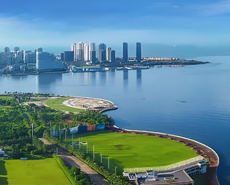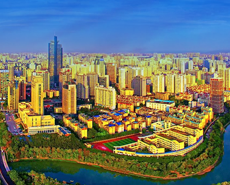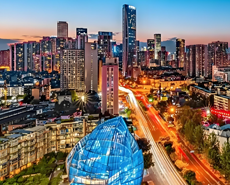Pursue excellence and dedicate to serving customers
----Interview with Lin Jianguang
General Manager
Hangzhou Ruibang Metal Co., Ltd.
Formerly known as Hangzhou Jianfang Material Co., Ltd., Hangzhou Ruibang Metal Co., Ltd. was founded in 2004. The company has earnt a favourable reputation in the steel industry by adhering to the “Entity first, customer first” business philosophy. It has built long-term cooperation with several state-owned and famous home-appliance enterprises.
Asian Metal: Good afternoon, Mr. Lin. Thanks a lot for agreeing to the interview. Please could you briefly tell us about your company.
Lin: It’s my pleasure. Headquartered in Hangzhou and branched in Ningbo, Hangzhou Ruibang Metal Co., Ltd. mainly deals with carbon and low-alloy hot-rolled coils, with the monthly trading volume of around 40,000 tons. We have built regular and excellent relationships with major producers such as Ningbo Steel, Masteel, Shagang Steel, Rizhao Steel, WISCO and so on.
Asian Metal: Where are your materials sold? How about customers?
Lin: Materials from our company are mainly sold to Zhejiang, Jiangsu and Jiangxi province. Around 2/3 of our clients are end users, and the rest are traders.
Asian Metal: “Environmental protection” has been the highlight in the steel industry in recent one or two years. The central government required producers nearby Beijing-Tianjin-Hebei province to halve blast furnace operation during the heating season, the so-called “historical stringent production limit order”. However, as far as Asian Metal learnt, outputs from HRC mills mentioned above have not been cut obviously yet since producers are active in producing boosted by the high profit of above RMB1,000/t (USD150/t). What about delivery from southern mills?
Lin: It’s true. The output for HRC has not been cut as largely as expected, and that’s why recently prices were powerless to go up as they did in July-August dragged by the weak downstream demand. Participants overdrew the positive effect of production reduction.
It’s said that Masteel, Shagang Steel, Ningbo Steel and other neighboring producers have invested largely on environmental equipments previously, and they have reached or even exceeded the national environmental protection standard. Currently those mills are producing smoothly. Some small-sized steel pipe mills are forced to halt or reduce production.
Recently deliveries from mills were normal. To avoid potential risks, we refused to build large inventory and controlled stockpile within safety level.
Asian Metal: Prices for HRC haven gone through a down-up trend this year to date. They kept at a high level in January-February, and dropped by RMB800/t (USD121/t) in March-April, but rebounded by over RMB1,100/t (USD167/t) from Mid-May to Mid-August, and have kept going up and down since early September. What do you think is the reason for the frequent price fluctuation? Do you think the price will go up further in the remainder of 2017?
Lin: The steel market is highly influenced by policies from the government as well as the futures market, and that’s why prices soared in the traditional low season of May-August, but they were powerless to increase again in the “Golden September” and “Silver October”. The root cause is oversupply.
To be honest, I’m a little bit uncertain about the market prospect considering interweave of positive and negative news. Economic statistics for October were far below expectations, indicating an economy downside risk and manufacture recession for the fourth quarter. However, it is said that the downstream demand for construction steel is getting strong day by day boosted by the acceleration completion of the infrastructure investment target with the approach of the end of the year, which will surely stimulate the HRC market. What we can do now is to reduce inventory to avoid potential risks.
Asian Metal: How about the downstream demand?
Lin: Generally speaking, the current downstream demand is a little bit weak compared with that in past years. The demand from automobile and home-alliance industries shrink obviously. On the one hand, end users complain that prices for final products such as autos and home-alliances did not go up as largely and sharply as those of HRC, and their profits are narrowed down, so that they are inactive in purchasing, while on the other hand, restrict environmental protection policies forced lots of downstream manufactures to shut down, and the rigid demand was reduced.
Asian Metal: More than 1/3 steel companies have gone bankrupt in recent several years, and the whole industry face serious challenges. What do you think steel enterprises should do to adapt to the new normal?
Lin: Insufficient funds play as the main reason for the bankruptcy of these enterprises. The prevailing jointly capital guarantee will make lots of companies go bankrupt in succession once one enterprise fail to pay money back to banks.
Personally I think the fundamental of one enterprise is to do solid work and must not be blindly greedy. Adhering to the philosophy, we recorded considerable profits even during the financial crisis year of 2008.
Asian Metal: What’s your biggest challenge at present? What about your advantages?
Lin: The steel market is hard to figure out this year since it is mostly influenced by the capital market, and it seems that participants pay little attention to the fundamental supply and demand.
Based on solid financial strength, we guarantee smooth goods flow. Besides, we focus on entities and are not involved in the capital market, which safeguard us to serve well customers. We stick to the values of integrity, respect and professionalism.
Asian Metal: Thanks so much for your time.
















